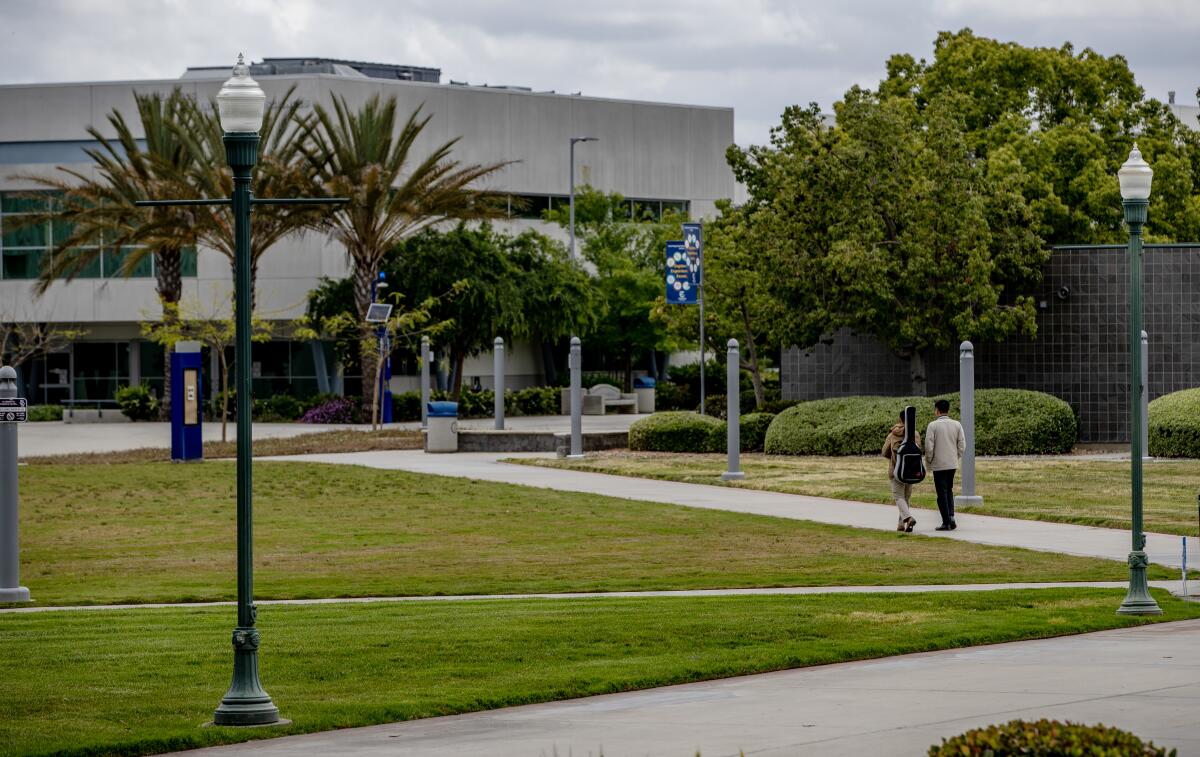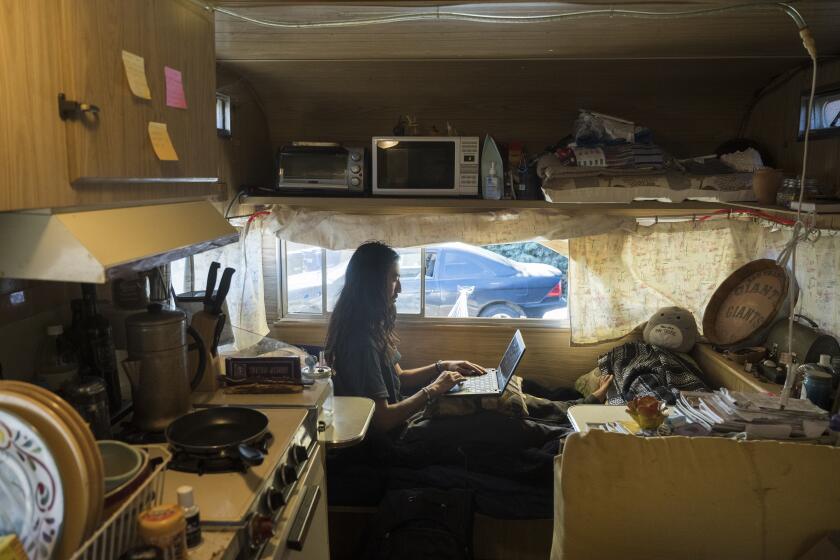Community colleges push for more affordable housing. But will California pay for it?

- Share via
Plans to build affordable housing for 400 community college students at Cerritos College are all drawn up, featuring communal kitchens and spaces where tutors and mental health specialists can visit students. The expected per-person rent for a four-bedroom, two-bedroom or studio unit? About $717 a month.
“The community college housing project is a project that will transform the lives of our students. And I’m not saying that just in a hyperbole,” said Cerritos College President Jose Fierro. “What we have seen is that when we give them that opportunity, they perform better in the classroom.”
The proposal and nearly two dozen others in the California Community College system are among a new generation of affordable housing projects aimed at bringing stability to underserved community college students, many of whom are under immense pressure to balance school and work, amid skyrocketing rent and other costs.
But the Cerritos plan is missing a critical element: money. Cerritos intends to kick in $12 million, but needs state funding to make up the rest of the $80-million cost. College officials are hoping to draw from a pool of money set aside by the state to fund housing projects at public colleges and universities.
But demand for affordable college housing is fierce and dollars limited among California’s three systems of higher education. Although campus dorms and apartments have long been a feature of University of California and Cal State campuses, the more recent foray into housing by community colleges has prompted questions about how — or even if — those projects should be prioritized for state money.

Faced with a potential budget shortfall, Gov. Gavin Newsom has proposed delaying by one year $250 million of the $750 million that was intended to support the grant program in 2023-24. He also proposed hitting pause on the start of a revolving loan program for campus housing construction. Lawmakers have weighed these delays in recent weeks as they prepare to approve a budget by June 30.
The proposed delays amount to a fraction of what the state has already promised for student housing. Newsom still plans to make at least $500 million available for housing in 2023-24, building off $1.4 billion in construction grants the state issued last year.
But in a state where scarce affordable housing forces some students to sleep in cars, live in motels or commute long distances to pursue their education, there isn’t enough construction money.
Colleges and universities across the state’s three systems submitted proposals in hopes of receiving grants for student housing through the 2023-24 budget. Thirty projects — including 21 from community colleges — totaling $2.1 billion were submitted, far exceeding available dollars.
And in the scramble for state funding, community colleges have had to withstand doubts over whether they are prepared to operate student housing.
The California Legislative Analyst’s Office, which advises the Legislature on fiscal and policy matters, made a series of recommendations, including a suggestion that lawmakers prioritize UC and CSU projects over those at community colleges.
“The universities have had a long history of building and operating residential buildings for students,” Paul Steenhausen, an analyst in the Legislative Analyst’s Office, said during an April hearing. “Universities likely would have a higher probability of implementing them successfully.”
Multiple lawmakers have said they do not support delaying additional money for student housing altogether. But there appears to be some support for prioritizing projects at universities in the next round of funding.
“In all honesty, a lot of the community college projects, they’re not ready for prime time,” said Assemblymember Kevin McCarty (D-Sacramento) during a March subcommittee hearing on education finance. “If you look at the staging of the money, we should focus on the projects that are most shovel ready. Now, those seem to be most of the UC and CSU projects.”
Community college leaders have fought back. They argue housing is urgently needed on two-year campuses, which educate the bulk of the state’s college students at a low cost. They cite data that show 1 in 5 community college students experience homelessness, a rate higher than in the UC and CSU systems. Nearly 65% are considered economically disadvantaged.
Lizette Navarette, interim deputy chancellor for California Community Colleges, said building affordable student housing is a fundamental part of caring for students.
“We don’t want to see them on the streets. We don’t want to see them in parking lots,” she said during an April hearing. “We want to see them housed with dignity and in a way that can help them achieve their academic goals and economic mobility for them and their families.”
Before 2019, less than a dozen of the state’s 116 community colleges offered student housing. Most were in rural communities and housed fewer than 200 students.
Community colleges in more urban and suburban areas have ventured into housing in recent years. In fall 2020, Orange Coast College in Costa Mesa opened the Harbour, an on-campus housing complex that can accommodate 800 students. Last year, the state issued grants to construct housing at a dozen community colleges, including Compton College, Fresno City College and Napa Valley College.
Cerritos hopes to benefit from the next round of grants. Its plans for a 400-bed apartment building ranked as the top proposal among 21 plans submitted by community colleges to the state’s chancellor’s office this year.
The college is still working out the details of how students will qualify for housing. But Fierro said they will have to meet certain enrollment and academic performance requirements.
Litigation blocking student housing projects, a potential delay in state funding and escalating construction costs are among the challenges.
Fierro said he does not think it is fair to have community colleges vie for state dollars with UC and CSU. Affordable housing is also direly needed in the UC and CSU systems — and an estimated 417,000 students across all three systems lack stable places to sleep, according to surveys.
“We’re just simply asking for the dollars to be allocated in a fair manner, for all of us to work together to find solutions to meet the housing needs,” Fierro said. “I do not agree with the way in which the three systems are being pitted against each other.”
In a 2019 survey by Cerritos College, 15% of students who responded said they experienced homelessness within the last year. Many more said they dealt with housing insecurity.
The Norwalk college offers an array of services to students in need. Students are free to use showers in the campus gym. The college operates the Falcon’s Nest, a hub for resources where students can place online orders for produce, canned goods and toiletries at no cost, or browse racks filled with donated blazers and blouses.

And in June 2020, the college opened the Village, a community of seven townhouses for students experiencing homelessness that are managed by the nonprofit organization Jovenes. Administrators say they’ve already seen how the housing has improved students’ lives and academics.
The average rate of students at Cerritos who receive their associate’s degree or career certificates in two years is 15%, according to Pamela Sepulveda, case manager of basic needs. For students who have lived in the townhouses — although they can only house 28 students at a time — that number jumps to 41%.
The campus mainly draws students from Cerritos, Bellflower, Downey and Norwalk. In 2021-22, 55% of students at the college received Pell Grants, federal money awarded to students from families with great financial need.
Between fall 2021 and fall 2022, the number of Cerritos students seeking rental subsidies from the college jumped 149%, Sepulveda said. The influx of requests happened after California lifted its statewide moratorium on evictions last year.
The college started the academic year with $100,000 to assist students with rent. The program blew past its budget and had to stop accepting requests in April, which means Sepulveda will have to refer students to outside resources for the last two months of the school year.
“I’ve spent over $143,000 just paying people’s rent to keep them housed,” she said.
Cerritos also works with Jovenes to find apartments for students who have families. And the college places students who need immediate housing in motels for a few weeks while helping them find longer-term housing.
Despite those programs, Sepulveda must still refer dozens of students who seek her help to the county-run program that coordinates housing services. That system handles requests from everyone in the community, which often means students may face long wait times before receiving help.
“We’re sending students into a housing system we don’t have weekly contact with,” Sepulveda said. “If I could duplicate my program and make it 10 times as large, then we might be able to address the housing issue.”
More to Read
Sign up for Essential California
The most important California stories and recommendations in your inbox every morning.
You may occasionally receive promotional content from the Los Angeles Times.












